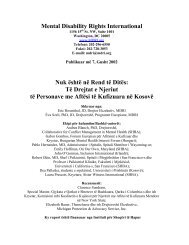Torture not Treatment - Disability Rights International
Torture not Treatment - Disability Rights International
Torture not Treatment - Disability Rights International
Create successful ePaper yourself
Turn your PDF publications into a flip-book with our unique Google optimized e-Paper software.
TORTURE NOT TREATMENT<br />
same arguments over and over again. The only time I ever prevailed against JRC was<br />
when my client was transferred to Mass General Hospital and I brought the case to a<br />
court that had never before heard from JRC. – MDRI interview with an attorney<br />
formerly involved with JRC litigation 193<br />
Despite each person being awarded a public counsel to protect their best interest and civil rights,<br />
the court rarely denies JRC permission to use punishment as treatment. The procedural<br />
protections seem impressive on paper, but they have proved ineffective and futile.<br />
When the JRC settlement agreement was first executed, a small cadre of defense<br />
attorneys handled all the JRC cases. However, after a few years of frustration and<br />
disappointment, all the original attorneys opted out. – MDRI interview with an attorney,<br />
formerly involved with the JRC substituted judgment cases 194<br />
In theory, shock can<strong>not</strong> be authorized by the court until all other avenues of treatment have<br />
failed. In practice, as described above, JRC appears to be able to create the behavior patterns that<br />
can justify the court to order shock. One mother of a new student reported to MDRI that her son<br />
was permanently restrained in a chair for several months, alone in a room, upon his admission to<br />
JRC. During that time, according to her, her son was understandably upset and angry – inducing<br />
him to exhibit bad behaviors. These behaviors were documented by JRC staff, and they give<br />
them the ammunition they needed to get judicial authorization to use the electric shocks on her<br />
son. 195<br />
Deaths and subsequent legal challenges<br />
From the outset, Israel‘s treatment for children with disabilities was controversial and the focus<br />
of much media attention. This was especially true when the magnitude and severity of<br />
punishments being perpetrated against children came to light or when an unexplained death<br />
occurred at the facility, of which there have been six. As previously described, it was a death at<br />
the facility in 1980 that resulted in the virtual ban on the use of aversives in California.<br />
In 1990, the Massachusetts DMR conducted an exhaustive investigation on the horrific death of<br />
a 19 year old, a young woman diagnosed with severe mental retardation, who also died at the<br />
facility. The report states that the staff and administration committed acts against her that were<br />
―egregious‖ and ―inhumane beyond all reason‖ and violated ―universal standards of human<br />
decency.‖ 196 The young woman, who was unable to speak, became ill and refused to eat,<br />
attempted to vomit and made sounds and noises that were <strong>not</strong> usual for her. For this she was<br />
punished repeatedly as the staff translated her actions as misbehaviors. In the hours leading up to<br />
her death from a perforated stomach and ulcers, the investigation found that she endured ―8<br />
spankings, 27 finger pinches, 14 muscle squeezes‖ and was forced to smell ammonia and eat<br />
―either vinegar mix, or jalapeno peppers or hot sauce.‖ 197<br />
35




